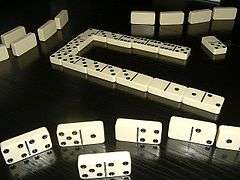
Domino (comics)
Domino (Neena Thurman) is a fictional superhero appearing in American comic books published by Marvel Comics. She is best known as a member of the X-Men offshoot X-Force. Created by writer Fabian Nicieza and artist/co-writer Rob Liefeld, she first fully appeared in X-Force, vol. 1 #11 (June 1992).
In addition to her exceptional marksmanship and hand-to-hand skills, Domino possesses mutant probability-altering powers, similar to those of the X-Man Longshot. She often uses her skills as a mercenary, but has also been the partner, confidante, and lover of the superhero Cable, a lieutenant in his militant group X-Force, and a member of the X-Men.
Publication history
Apart from being a mainstay character in the first series of X-Force, Domino has had two limited self-titled series, one of which had her teaming with Puck against Lady Deathstrike and Donald Pierce. The second revealed her childhood.
Domino did not properly appear in Marvel comics until after a pair of false starts. A Domino imposter, a mutant shapeshifter named Copycat, first appeared in New Mutants, vol. 1 #98 (February 1991), although the real Domino did not appear in that issue. Domino made a brief appearance in a flashback in X-Force, vol. 1 #8 (March 1992), and made her first actual present-day appearance on the last page of issue #11 (June 1992). She appeared in a number of issues of Cable & Deadpool and joined the first Wolverine-led X-Force as of X-Force, vol. 3 #8 (December 2008).

Dominoes
Dominoes (or dominos) is a game played with rectangular "domino" tiles. The domino gaming pieces make up a domino set, sometimes called a deck or pack. The traditional Sino-European domino set consists of 28 dominoes, colloquially nicknamed bones, cards, tiles, tickets, stones, or spinners. Each domino is a rectangular tile with a line dividing its face into two square ends. Each end is marked with a number of spots (also called pips, nips, or dobs) or is blank. The backs of the dominoes in a set are indistinguishable, either blank or having some common design. A domino set is a generic gaming device, similar to playing cards or dice, in that a variety of games can be played with a set.
The earliest mention of dominoes is from Song dynasty China, found in the text Former Events in Wulin. Dominoes first appeared in Italy during the 18th century, and although it is unknown how Chinese dominoes developed into the modern game, it is speculated that Italian missionaries in China may have brought the game to Europe.
Ludwig & Mayer
Ludwig & Mayer was a German type foundry in Frankfurt am Main, Germany. Many important designers worked for the Ludwig and Mayer type foundry, including Heinrich Jost, Karlgeorg Hoefer, Helmut Matheis, and most notably Jakob Erbar, whose Erbar Book was one of the first geometric sans-serif typefaces, predating both Paul Renner's Futura and Rudolf Koch's Kabel by some five years. Starting in 1925, Ludwig & Mayer types were distributed in the United States by Continental Type Founders Association. When the foundry ceased operations in 1984, rights to the typefaces was transmitted to the Neufville Foundry.
Typefaces
These foundry types were produced by Ludwig & Mayer:
Domino (Genesis song)
"Domino" is a song written by the band Genesis for their 1986 album Invisible Touch. The song was the sixth track on the album. The music was written by the band, while the lyrics were written by keyboardist Tony Banks. The song is divided into two parts, "In the Glow of the Night" and "The Last Domino".
The song, though not released as a single, charted at number 29 on the Mainstream Rock Charts.
The B-side of the "Tonight, Tonight, Tonight" single was the first half of this song, "In the Glow of the Night", while the B-side of "Invisible Touch" was the second part of the song, "The Last Domino".
During a clip titled "Tony talks about his inspiration" on the When in Rome 2007 DVD, Banks states that his inspiration for the song lyrics was the 1982 Lebanon War which was still being contested prior to the recording of Invisible Touch. He set the action on a hotel room in Beirut, minutes after bombs start to fall on the city.
Chart performance
Live performances
Before the song was performed, Phil Collins would talk to the audience about the Domino Principle and demonstrate it by stating that something that might happen to the people in one section, might affect the people in another section (with the lights lighting up that section of the audience) multiple times.
Podcasts:

